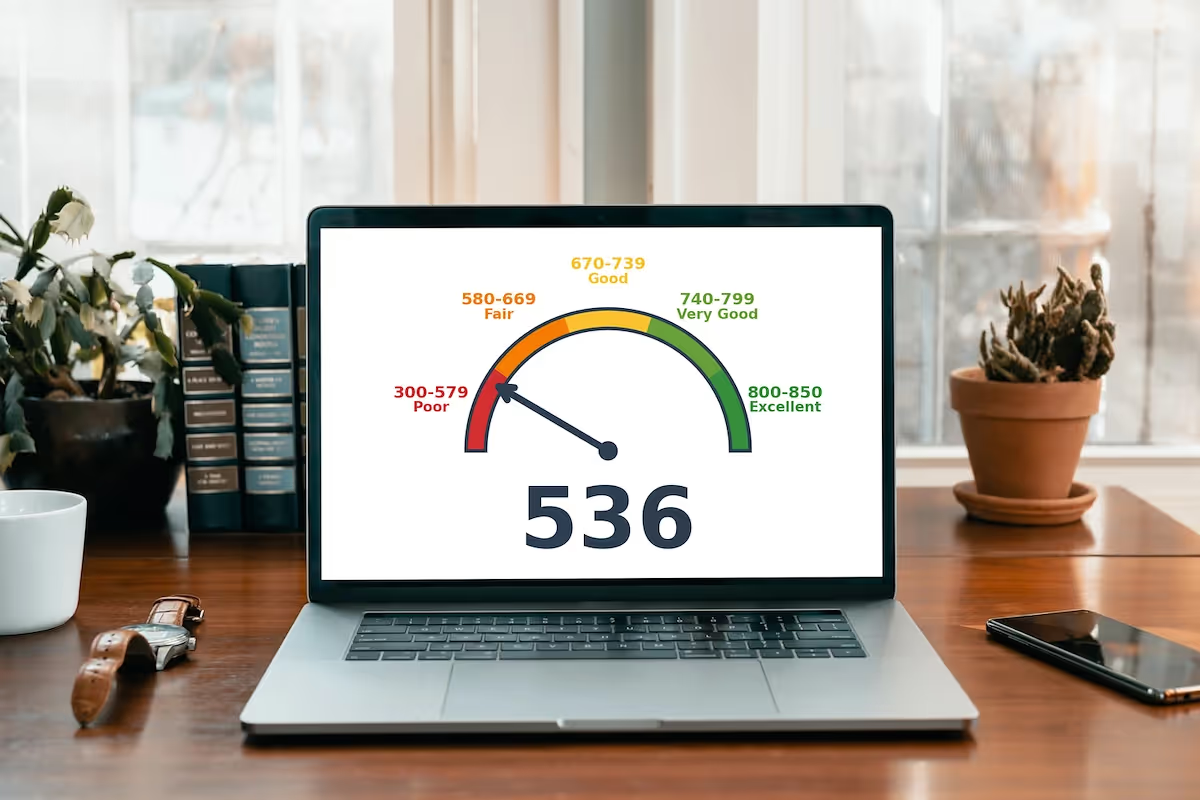
Kudos has partnered with CardRatings and Red Ventures for our coverage of credit card products. Kudos, CardRatings, and Red Ventures may receive a commission from card issuers. Kudos may receive commission from card issuers. Some of the card offers that appear on Kudos are from advertisers and may impact how and where card products appear on the site. Kudos tries to include as many card companies and offers as we are aware of, including offers from issuers that don't pay us, but we may not cover all card companies or all available card offers. You don't have to use our links, but we're grateful when you do!
536 Credit score: What You Need to Know in 2025
July 1, 2025


TL;DR
While a 536 credit score presents some challenges, it provides a clear starting point for improving your financial standing. This score falls into the "Poor" FICO® Score category, which means there is a significant opportunity to build a stronger credit history from here.
What Does a 536 Credit Score Mean?
A credit score of 536 falls into the "poor" range on the FICO scale, signaling to lenders that you may be a high-risk borrower. This can make it difficult to get approved for new credit, such as loans or credit cards. If you are approved, you'll likely face unfavorable terms, including higher interest rates and fees, which makes borrowing more expensive.
While this score presents financial hurdles, it's not a permanent label. It serves as a baseline from which you can build a stronger credit history. Understanding where you stand is the first step toward improving your financial standing. Over time, it is possible to move into higher credit score ranges, unlocking better financial opportunities for your future.
Who Has a 536 Credit Score?
While age isn't a direct factor in credit scoring, there is a clear trend of scores improving over time. According to 2023 data on average credit scores by generation, the breakdown is as follows:
- Generation Z (ages 18-26): 680
- Millennials (ages 27-42): 690
- Generation X (ages 43-58): 709
- Baby Boomers (ages 59-77): 745
- Silent Generation (ages 78+): 760
Credit Cards With a 536 Credit Score
A credit score of 536 is considered to be in the poor range, which can significantly impact your ability to obtain a credit card. Lenders generally view applicants with scores in this range as high-risk, making it challenging to get approved for traditional, unsecured cards with favorable terms. Consequently, your options will likely be limited to secured credit cards or specific subprime cards designed to help you rebuild your credit history.
Kudos can help you find the right card for your situation with its Explore Tool, which uses a quiz to understand your financial priorities, like finding a low interest rate. The tool then provides personalized, unbiased recommendations from a database of nearly 3,000 cards to match your needs.
Auto Loans and a 536 Credit Score
A 536 credit score places you in the subprime lending category, which can make securing an auto loan more challenging. Lenders view this score as higher risk, often resulting in significantly higher interest rates compared to borrowers with stronger credit profiles.
According to Experian's Q2 2025 data, here is how average auto loan rates break down by credit score:
- Super-prime (781-850): 5.25% for new cars, 7.13% for used cars
- Prime (661-780): 6.87% for new cars, 9.36% for used cars
- Non-prime (601-660): 9.83% for new cars, 13.92% for used cars
- Subprime (501-600): 13.18% for new cars, 18.86% for used cars
- Deep subprime (300-500): 15.77% for new cars, 21.55% for used cars
Mortgages at a 536 Credit Score
A 536 credit score places you in the 'bad' credit category, which severely limits your mortgage options. However, it doesn't entirely disqualify you from buying a home. Your most realistic option is an FHA loan, which is insured by the federal government. Loan requirement data shows that FHA guidelines permit scores as low as 500. Other government-backed loans, like VA or USDA, are less likely, as lenders typically set their own minimums around 580 to 620.
Securing a loan with a 536 score comes with significant trade-offs. For an FHA loan, you must provide a minimum down payment of 10%, a substantial increase from the 3.5% required for borrowers with scores of 580 or higher. You can also expect to face higher interest rates, costlier mortgage insurance fees, and a more rigorous underwriting process where lenders will manually scrutinize your income, employment history, and overall financial stability to offset the risk.
What's in a Credit Score?
Figuring out what goes into your credit score can feel like trying to solve a complex puzzle, but it generally boils down to a handful of key elements. The most common factors include:
- Your payment history, which tracks whether you pay your bills on time, is the most significant factor.
- Credit utilization, or the amount of credit you're using compared to your total available credit, also plays a major role.
- The length of your credit history demonstrates your experience with managing credit over time.
- Having a healthy mix of different types of credit, such as credit cards and installment loans, can positively impact your score.
- Finally, recent credit inquiries, which occur when you apply for new credit, are also taken into account.
How to Improve Your 536 Credit Score
Don't be discouraged by a 536 credit score; improving your credit is achievable with consistent effort and the right financial habits. According to an expert guide for 2025, taking a few key steps can lead to meaningful changes over time.
- Set up automatic bill payments. Your payment history is the most significant factor in your score, so paying bills on time is the most important step you can take. This builds a positive track record from the ground up and demonstrates reliability to lenders.
- Apply for a secured credit card. With a 536 score, a secured card is an accessible tool that allows you to build a positive payment history. Making consistent, on-time payments proves you can manage credit responsibly, which is essential for improving your score.
- Become an authorized user. Being added to a credit card account of someone with a strong payment history can add their positive data to your credit file. This can help improve your score by increasing the average age of your accounts and adding a record of on-time payments.
- Monitor your credit reports. Regularly check your reports from all three bureaus for inaccuracies or fraudulent accounts that could be dragging your score down. Disputing and removing errors is one of the fastest ways to see a potential score increase.
As you work on these steps, consider using a tool like Kudos to help you make smart decisions and maximize rewards with the credit cards you use.
Unlock your extra benefits when you become a Kudos member

Turn your online shopping into even more rewards

Join over 400,000 members simplifying their finances

Editorial Disclosure: Opinions expressed here are those of Kudos alone, not those of any bank, credit card issuer, hotel, airline, or other entity. This content has not been reviewed, approved or otherwise endorsed by any of the entities included within the post.



































.webp)



.webp)



.webp)

